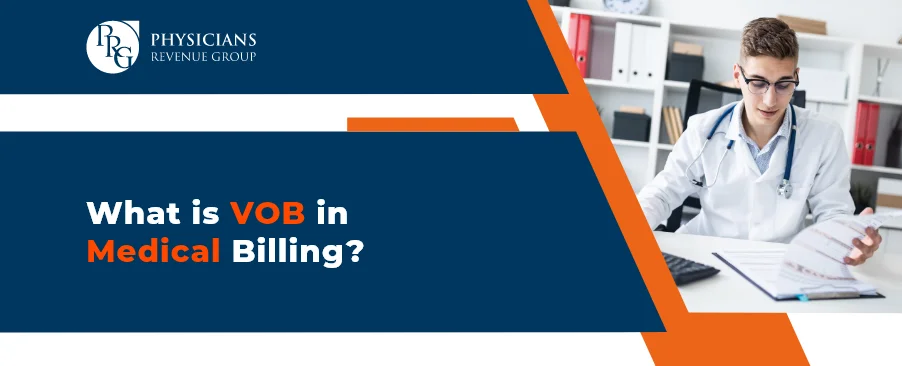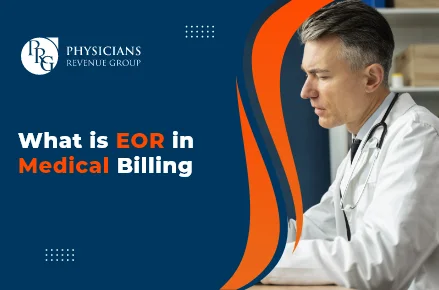
Email: info@prgmd.com | Call: +1 (630) 242-6474
Business hours: 9:00 to 5:00 | Monday to Friday
Email: info@prgmd.com | Call: +1 (630) 242-6474
Business hours: 9:00 to 5:00 | Monday to Friday

Table of Contents
ToggleFor smooth operations inside medical billing services – healthcare practitioners must confirm a patient’s coverage to evaluate their financial responsibility. Healthcare practices can check on the coverage provided by the health plans in addition to the deductibles, co-insurance, and copayments. The entire process can be carried out with the patient eligibility process and VOB in medical billing.
Eligibility verification in healthcare RCM encourages collecting coverage status and minimizes the risk of claim denials. Furthermore, verification of benefits and patient eligibility enables providers to get payments in advance, avoiding delays in cash realization.
VOB, or verification of benefits, is an essential step in the insurance claims and medical billing process. The step involves verifying a patient’s health insurance coverage and the benefits they receive for specific treatment or services.
The process involves checking with a patient’s insurance provider to determine the following:
Eligibility Verification – verify whether or not a patient’s insurance plan is active or whether it covers the medical treatment/services they are seeking.
Coverage Verification – here, providers determine the extent of coverage for specific medical services; such coverage may or may not include:
Pre-authorization – is also essential to ensure that pre-authorization is not needed for a particular planned medical procedure.
Let’s explore VOB in medical billing in depth:
During the verification process, the following information is verified:
VOB has an essential role in medical billing, and that is for several reasons, including:
Accuracy – by verifying patient insurance benefits, medical providers can estimate a patient’s financial responsibility. That alone helps minimize billing errors and also avoid surprise-unexpected costs for patients.
Transparency in Costs – Patients can make informed decisions about their medical care and treatment by ensuring cost transparency. Especially when patient know and understand their financial responsibility upfront. Here, VOB in medical billing helps provide cost transparency.
Claim Rejections – If left unverified, insurance information can lead to claim rejections, resulting in reimbursement delays. VOB can help reduce claim denials and ensure fast payments.
Compliance – VOB in the medical billing process ensures provider compliance with the insurance guidelines and policies. Ensuring healthcare providers’ compliance can minimize legal and compliance risks.
Healthcare providers must check a patient’s eligibility 48 hours before their appointment. If this is not possible, it must be done in real-time before the treatment – during patient check-in. On-time eligibility checks help in reducing the number of claim denials.
Moreover, electronic eligibility verification or checking is available in most EHRs. Following the timelines of eligibility verification, your practice can reduce denials. Additionally, your practice can boost revenue realization through timely verification of patient coverage before delivering treatment.
ERA is a vital element in the post-service phase of medical billing. It provides healthcare providers with detailed and standardized information about the adjudication of a healthcare claim. When linked to the Verification of Benefits process, ERA helps streamline the financial aspects of healthcare services. Before a medical procedure, VOB involves checking and confirming a patient’s insurance coverage and benefits. Once the service is provided and a claim is submitted, ERA electronically delivers comprehensive information on how the claim was processed. This includes details such as:
By integrating ERA into the medical billing workflow, providers can reconcile the payment received with the expected reimbursement based on the verified benefits. This synchronization helps reduce errors, enhance accuracy, and expedite reimbursement.
EOR is another essential component in the medical billing process, providing a detailed breakdown of a healthcare claim’s processing. For VOBs, EOR complements the pre-service verification. Before rendering medical services, the Verification of Benefits process allows healthcare providers to understand the patient’s insurance coverage, copayments, and deductibles. After the service is provided, the subsequent EOR delivers a comprehensive statement explaining the adjudication of the claim. This includes details such as:
By linking VOB with EOR, healthcare providers can ensure that the expected coverage aligns with the actual reimbursements. This connection reduces billing discrepancies, improving transparency and facilitating patient communication regarding financial responsibilities.
ERA and EOR are integral to the post-service phase of medical billing, providing electronic documentation of claim adjudication and explanations of benefits. When linked to the pre-service verification of benefits process, these components contribute to an accurate financial workflow, enhancing the overall efficiency of healthcare billing practices.
Incorporating best practices for insurance verification and eligibility criteria helps create positive patient experiences. It simultaneously lowers the administrative load and reduces the number of claim denials. Furthermore, it can boost patient satisfaction levels while ensuring that physicians receive adequate payments for their services.
Some of the best practices include:
Share:
Categories
Recently Added

What is an ABN in medical billing?

What does a Clearinghouse do During Claims Submission?

What is EOR in Medical Billing?
We Would Love to Assist You!
We treat your data confidentially and don’t share any information with a third party.